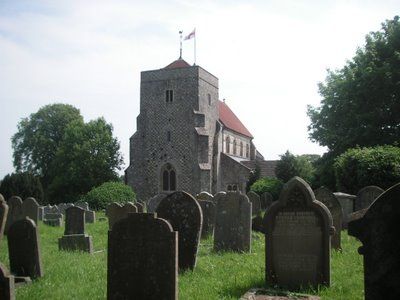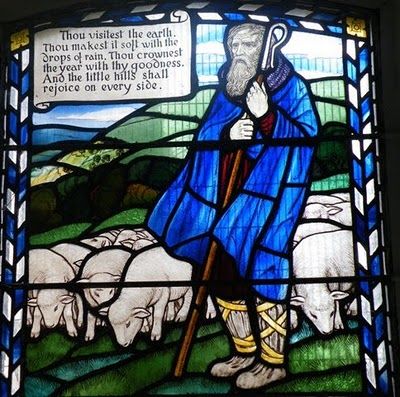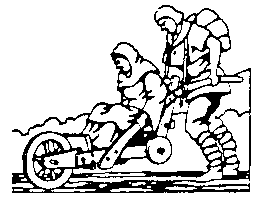Of man and God like root and sky; the son
Of a Cornish shepherd, Cuthman, the boy with a cart,
The boy we saw trudging the sheep-tracks with his mother
Mile upon mile over five counties; one
Fixed purpose biting his heels and lifting his heart.
We saw him; we saw him with a grass in his mouth, chewing
And traveling. We saw him building at last
A church among whortleberries…
(Christopher Fry)
Today, February 8, we celebrate the feast of Saint Cuthman of Steyning (died, ninth century), English church builder and miracle worker. The life of Saint Cuthman is one of holy legend, recounting his various exploits made possible only through the grace of God. Regardless of the veracity of these legends, what we take from the life of Saint Cuthman is a profound respect and love for his mother, a dedicated service to the Lord, and unwavering faith—all lessons we can apply to our own lives today.
Cuthman was born into a wealthy English family in Chidham, and worked as a shepherd, grazing the family’s flocks. Pious from an early age, he was steadfast and faithful, never failing in his religious observances or his work in the fields. It is said that through the power of prayer, Cuthman was able to keep his grazing sheep safe in a circle under his watchful eye. Following his father’s death, who per legend was killed by Vikings, he was left to care for his sick and elderly mother, who subsequent to a disease was unable to walk without assistance.
One afternoon, while praying over his sheep, Saint Cuthman received a command from the Lord: to travel east into the pagan countryside and erect a church. The Lord promised that Cuthman would known where to erect this church by a heavenly sign. Saint Cuthman desired nothing more than to obey, but worried about his mother. She could not be left behind, and it would be incredibly difficult to take her with him. However, ever obedient, he sold his flocks and bought a cart in which to transport his mother. Tying a rope halter around his neck, he set off over the bumpy and muddy roads, pulling his mother behind him.
Now, this travel was not easy, given the condition of the roads and the weight of his mother. Yet Saint Cuthman proceeded night and day, rarely stopping for food or rest until his halter frayed and snapped. Having used all his money to buy the cart, he was unable to buy more rope, so instead cut some elder branches to fashion a new halter. The farmers in a nearby field, observing what they considered foolish behavior, mocked him. But Cuthman continued on his way, saying to them: “Men mock and heaven shall weep!” at which a rainstorm flooded their fields and destroyed their crops. It is said that every spring these same fields are flooded.
Saint Cuthman continued on his journey, pulling his mother, until his elder-twig halter snapped. This happened by a pagan mound topped by a stone (see picture), and Cuthman took this as the sign where he should erect his church. He prayed on the spot:
Father Almighty, you have brought my wanderings to an end; now enable me to begin this work. For who am I, Lord, that I should build a house to your Name? If I rely on myself, it will be of no avail, but it is you who will assist me. You have given me the desire to be a builder; make up for my lack of skill, and bring the work of building this holy house to its completion.
 |
| The stone of Saint Cuthman |
During the course of construction, many miracles occurred at the intercession of Saint Cuthman. For example, while fitting the roof beams, a stranger appeared to assist. This stranger, who legend tells us was Saint Andrew, hung his leather gloves on a sunbeam while assisting Cuthman. On another occasion, when Cuthman was feeling discouraged by obstacles to construction, a stranger appeared and told him how to remedy the trouble, saying;
" Nothing is wanting to those that fear the Lord."
Saint Cuthman, overcome with awe, asked for the stranger’s name.
" I am He," was the answer, "in whose name thou buildest this temple."
Saint Cuthman was similarly targeted by a local pagan wise-woman and the devil. Objecting to his Christianity and “divine works,” she stole his oxen to use as her own. In return, Cuthman harnessed her two sons to his plow, using them as substitutes, and so successfully rebutted her curse that the woman flew high into the air. Upon landing, legend tells us that the ground swallowed her hole, with the devil claiming her as his own. The devil, for his part, attempted to dam the entire area in one evening and flood away the holy church, but Saint Cuthman tricked the devil by knocking roosters off their perches (so they would signal daybreak early) and flashing a candle behind a sieve to simulate the rising sun. The devil fled, having failed in his task.
 |
| The Church of Saint Andrew, located on the site of Saint Cuthman's Church |
The life of Saint Cuthman is a reminder and example of filial piety, prayer, hard work, and faith. His life and legends serve to remind us of the importance of obedience, confidence in the Lord, and steadfast forbearance in the face of adversity and discouragement. We are called to remember that “Nothing is wanting to those who fear the Lord.”
Year 2: Day 39 of 365
Prayer Intentions: Piety, Prayer, Hard Work.
Requested Intentions: Assistance with a legal matter, financial freedom (R); Healing for a friend (M); For a son in medical school (H); Financial assistance (M); Successful employment (N): Freedom from mental illness for a friend (L); For successful marriage (N); For friends having and recovering from surgery; for the reduction of a brain tumor (L); For resolution of a housing crisis (P); For a brother who is struggling financially, for a son who is struggling academically (B); For financial security for a friend (C); Success in business; familial happiness and health (J); Health and recovery of a sister (I); Development of a chaste relationship pleasing to the Lord (E); Successful surgery of mother; delivery of daughters’ babies (L); For a friend suffering with depression (M); For a friend entering religious life (R); Success of a parish men’s retreat (H); For a mother who is grieving; for the soul of a dearly departed son (M); Reconciliation of a marriage (M); End to grief after death of son (B&C); End to grief (S); Successful marriage (N); For an RCIA candidate struggling with financial and family stressors (O); Freedom from anxiety regarding medical procedure (J); Return home of an ill mother, peace and financial security (J); Healing of a father following stroke (S).








No comments:
Post a Comment
Thanks for leaving a comment. If you wish to submit a prayer request, however, please do so above, using the "Contact" tab.